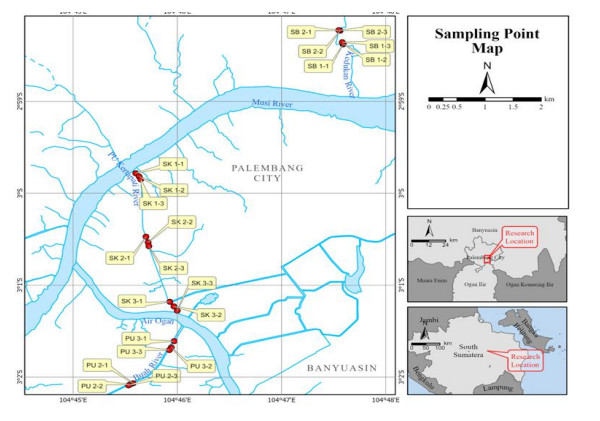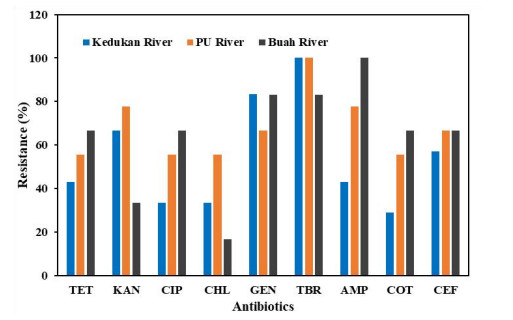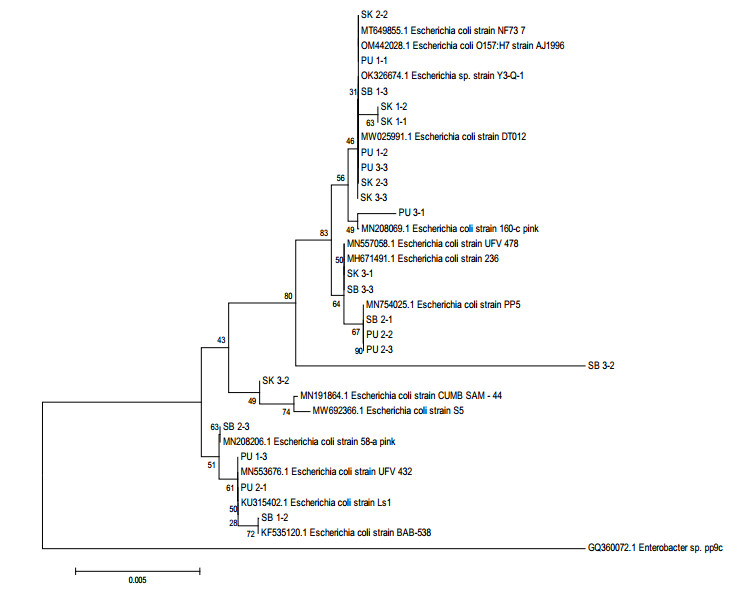1.
Introduction
In Indonesia, diarrhea is an endemic disease, and it has the potential to cause events that often lead to death. Furthermore, a total of 4,504,524 cases of the condition were recorded in 2018 [1]. The World Health Organization also revealed that it is the second leading cause of mortality among children below five years, with approximately 370,000 global deaths, in 2019. The Palembang City health officials reported that there was an increase in its prevalence in 2018 when 43,177 people were affected. Diarrhea cases in the city are dominant in areas with poor sanitation, especially densely populated riverbanks with poor environmental sanitation. The Seberang Ulu I, Kertapati, and Ilir Timur II sub-districts in Palembang are part of the areas with high prevalence in 2016 [2]. The poor sanitation in these regions is caused by the presence of river flow. The Kedukan, PU, and Buah rivers are located in the Seberang Ulu 1, Kertapati, and Ilir Timur 2 sub-districts, respectively. People living on the banks still use the water for hygiene and sanitation needs, as well as washing, bathing, and defecating. They also dispose of food waste, garbage, washing boats, and feces in the rivers.
Diarrhea is often caused by Escherichia coli (E. Coli), which is transmitted through water contaminated with feces [3]. The pathogen caused the outbreak of the disease that occurred in Germany with 830 cases of Hemolytic Uremic Syndrome (HUS) and 46 deaths [4,5]. Furthermore, E. coli is a type a commensal bacteria as well as an intestinal and extra-intestinal pathogen, which can cause urinary tract infections (UTI), meningitis, and septicemia [6]. Several studies also reported that it is the major pathogen for UTI [7,8,9]. E. coli infection can lead to meningitis, which is a leading cause of mortality and morbidity globally [10,11,12]. It is also the cause of severe sepsis and septic shock in Medellín, Colombia [13].
The discharge of household and industrial waste into rivers leads to the entry of heavy metals and other mutagens. Heavy metal contamination plays a role in increasing the resistivity of bacteria to antibiotics due to the core regulation of resistance genes. It also helps to reduce the susceptibility of pathogens to antibiotics. Furthermore, mutations occur due to DNA damage caused by hydrolysis, deamination, - and induction by mutagens in the form of heavy metals [14,15]. The presence of chlorine in detergents and the aquatic environment can cause serious health problems because it is a mutagenic agent for bacteria, which increases their resistance to various spectrum antibiotics. Triclosan [TCS; 5-chloro-2-(2, 4-dichloro phenoxy) phenol] is a chlorinated phenolic antimicrobial agent commonly used in commercial and healthcare products. It is often used to produce soaps, deodorants, shampoos, cosmetics, textiles, plastics, surgical sutures, and prosthetics. A previous study revealed that TCS could induce multi-antimicrobial resistance in E. coli [16]. The chlorination process promotes the horizontal transfer of plasmids through natural transformation, which causes the exchange of antibiotic-resistant genes across the bacterial genera. It also leads to the transfer of chlorine-induced opportunistic pathogens between the new variants [17,18].
Therefore, this study aims to isolate antibiotic-resistant E. coli and as to carry out a molecular identification of strains that contaminate river waters in Palembang City using the 16S rRNA gene. The identification method was used to determine the taxonomy, - and the phylogeny or evolutionary relationships of the test organism. It was also used to estimate the range of diversity between the bacterial species. A previous study reported that the comparison of rRNA sequences can reveal the evolutionary relationships between organisms [19,20,21]. Isolation and identification of antibiotic-resistant E. coli using 16S rRNA from rivers in Palembang City were performed to determine its isolates' distributions and genetic diversity.
2.
Materials and methods
2.1. Sampling Area
The samples were taken along the Kedukan, PU, - and Buah rivers in Palembang city. Furthermore, each river consists of 9 sampling points in the lower and middle parts as well as the upstream region, as shown in Figure 1. Surface water samples were collected for microbiological testing from 27 points using the purposive sampling method. They were taken using sterile bottles and then placed in a cool box at 4℃ before arriving at the laboratory. The samples were tested for water quality based on physical, chemical, and biological parameters. Measurements of pH and temperature were carried out directly in the field. The chemical variables tested include pH levels, biochemical oxygen demand (BOD) mg/L [22], chemical oxygen demand (COD) mg/L [23], Total suspended solids (TSS) mg/L [24], Fe mg/L [25], Cd mg/L [26], Pb mg/L [27] and Cl2 mg/L [28]. Furthermore, the biological parameters consisted of total microbial, fecal, - and non-fecal coliform content, while the physical parameters were color and temperature (℃). The total microbial testing was carried out using the Total Plate Count (TPC) method, and the amount of coliform and E. coli contamination was determined with the Most Probable Number method and variety two series 5:5:5 [29,30].
2.2. Haemolytic Test
A hemolytic activity test was carried out by streaking E. coli bacteria culture on blood agar media. It was then incubated for 24 hours at 37℃, followed by observations of the bacterial colonies formed.
2.3. Antibiotic Sensitivity Test
Sensitivity tests for antimicrobial agents were carried out using the Kirby-Bauer method based on the Institute for Clinical and Laboratory Standards. Colonies of E. coli were then obtained using a round loop and transferred into a tube containing 5 mL of 0.9% physiological NaCl. The turbidity of the suspension was adjusted with a 0.5 McFarland solution, which was prepared by adding 0.5 mL of 0.048 M BaCl2 (1.17% w/v BaCl2.2H2O) to 99.5 mL of 18 M H2SO4 1% v/v with constant stirring [31].
Approximately 0.5 mL of the suspension solution was taken and placed in a Petri dish containing Muller-Hinton Agar (MHA) media, followed by leveling. Subsequently, the paper disc containing the antibiotic was placed on MHA media and incubated in an inverted dish for 24 hours at 37 ℃. The zone of inhibition was then measured and interpreted based on the Clinical and Laboratory Standards Institute (CLSI) [32].
2.4. Identification of E. coli based on the 16S rRNA gene
Genomic DNA was extracted using Geneaid, which is also known as Bacteria Genomic DNA Kit. PCR assays using species-specific primers 27F (5'-AGAGTTTGATCCTGGCTCAG-3') and 1492R (5'-GGTTACCTTGTTACGACTT-3') to amplify ~1500 base pair (bp) products were carried out for identification based on the 16S rRNA gene [33]. The 25 L reaction mixture contained 1 x reaction buffer, 1 U Taq DNA-polymerase (Green GoTaq), 25 mM MgCl2, 2.5 mM dNTP mixture, 10 M primers, and 20 ng DNA templates. Subsequently, amplification was carried out in a 2720 Thermal Cycler (Applied Biosystems). The reaction conditions used were heating at 94℃ for 2 minutes, followed by 30 cycles at 92℃ for 30 seconds, 55℃ for 30 seconds, 72℃ for 1 minute, - and final elongation at 72℃ for 2 minutes. The water control was used in all the PCR tests to avoid contamination.
A total of 5 µL of the amplification product was separated on a 1.5% (w/v) agarose gel in Tris-acetate-EDTA (TAE) buffer. It was then stained with 0.5 g/ml ethidium bromide for 20 min at a constant voltage of 60 V, and the gel was photographed under ultraviolet light using the Alpha imager Gel Doc system. For each gel, a 100 bp DNA ladder (Promega) was used as a marker to determine the size of the amplicon.
2.5. Sequence Analysis
Phylogenetic analysis was performed on eleven 16S-rRNA gene sequences. Subsequently, they were edited using the sequence alignment editor BIOEDIT v.7.2.5 and aligned with MEGA version 10. The phylogenetic tree was then constructed on MEGA version 8 using neighbor-joining (NJ) method analysis with 1000 bootstrap replicates.
2.
Results and Discussion
3.1. The physical and chemical water quality
The results of the water quality analysis for the physical and chemical parameters obtained were compared with the river standards provided by Regulation of the Minister of Health of Indonesia No. 32 of 2017, as shown in Table 1. They include pH of 6-9, color (max 50 TCU), TSS (max 50 mg/L), BOD (max 2 mg/L), COD (max 10 mg/L), iron (Fe) (max 0.3 mg/L), cadmium (Cd) (max 0.1 mg/L), Lead (Pb) (max 0.3 mg/L), chlorine (Cl2) (max 0.03 mg/L), coliform (max 50 CFU/100 mL) and E. coli (0 CFU/100 mL).
Parameters that meet water quality standards are pH, temperature, color, TSS, Cd, and Pb. BOD levels in the Kedukan and Buah rivers did not meet the quality standard. The high BOD levels in the Kedukan and Buah rivers indicated the presence of numerous organic compounds due to the disposal of domestic waste from the community along the riverbanks. It was also caused by factories and livestock farms that dump their waste into the river. The high organic compound content in the wastewater also causes an increase in the value of suspended solids [34]. Furthermore, high BOD levels can lead to the death of aquatic biota because oxygen intake is fully absorbed by bacteria to decompose organic matter. This condition is often caused by a decrease in the organic and inorganic matter content of water [35]. In the Buah river, the COD levels were higher than the maximum quality standard, which indicates the presence of numerous pollutants.
The concentrations of Fe in the Kedukan and the PU rivers did not meet the quality standard. The increase in heavy metal content of waters is often caused by the entry of industrial, mining, agricultural, - and domestic waste. Although they are needed for various metabolic processes by aquatic organisms, increased levels can become toxic to the animals. Heavy metals that enter the body accumulate and continue along the food chain. Fe is one of the mutagens that can cause mutations or DNA damage [15]. The concentrations of chlorine in the Kedukan, PU, - and Buah rivers did not meet the quality standard. The increased chlorine concentration in rivers used as a source of drinking water harms health. Several studies reported that chlorine is a mutagen as well as a carcinogenic agent. Furthermore, it can cause asthma, irritation of the esophagus, burning sensations in the mouth and throat, and spontaneous vomiting [36]. It also leads to liver and bladder damage, as well as colon cancer, atherosclerosis, high blood pressure, and allergies [37].
3.2. The biological water quality
In the Kedukan, PU, and Buah rivers, the numbers of coliform bacteria and E. coli exceeded the standards of to the Regulation of Indonesia Minister of Health No. 32 of 2017, namely, max 50 CFU/100 mL and 0 CFU/100 mL, respectively (Table 2). The maximum amount of coliform contaminants, including fecal coliform and E. coli in drinking water, according to the Environmental Protection Agency (EPA) is 0 mg/L. The coliform bacteria can cause serious illnesses, such as gastroenteritis and diarrhea, through contaminated water from untreated sewage, and septic tanks [38]. Furthermore, it is also an indicator of the presence of pathogenic microbes that are harmful to health. E. coli bacteria in waters is caused by the entry of refuse that was received directly, such as domestic waste. Residential settlements are also inseparable from the act of disposing of digestive waste, such as feces and urine. These activities can stimulate the growth of coliform bacteria in the water.
3.3. Hemolysis ability of E. coli
Table 3 shows the hemolysis test results of E. coli isolates with codes (SK 1-1, 1-2, 2-2, 2-3, 3-2), (PU 1-3, 2-2, 2-3, 3-1, 3-3), - and (SB 1-2, 2-3). The test revealed the occurrence of Alpha Hemolysis, which is characterized by the partial destruction of red blood cell membranes. This causes the ejection of hemoglobin and other intracellular components into the surrounding fluid, and it was indicated by a greenish or brownish color change, which surrounds the bacterial colonies growing on agar media. Meanwhile, Beta Hemolysis occurred in the isolates with codes (SK 3-3, PU 1-1, 1-2) and (SB 1-3, 2-1, 3-3), characterized by a complete reduction of red blood cells and hemoglobin. Isolates (SK 3-1, PU 2-1, 3-2) and (SB 3-2) caused Gamma Hemolysis, which is invisible damage to blood components. The images of Alpha Hemolysis, Beta Hemolysis, and Gamma Hemolysis can be seen in Figure 2.
The ability of the bacterial cultures to carry out Beta Hemolysis on the Blood Agar Base media was indicated by the formation of colonies with clear zones around them. The total blood lysis process was confirmed by the formation of a completely clear zone. The incomplete hemolysis, which produced a greenish-colored medium, is known as Alpha Hemolysis. The greenish-gray or brownish color was obtained from biliverdin, which is a product of hemoglobin breakdown [39]. One of the characteristics of pathogenic bacteria is their ability to lyse red blood cells. However, the test isolates have no visible hemolytic activity (gamma hemolytic), which indicates that they are not pathogenic. E. coli is a bacterium with several virulence factors and toxins. Some of its strains obtained virulent abilities during evolution or mutations, which help them to infect their hosts.
3.4. Sensitivity of E. coli to antibiotics
Figure 3 shows E. coli isolate sensitivities to 9 antibiotics: tobramycin (TBR), ampicillin (AMP), tetracycline (TET), kanamycin (KAN), ciprofloxacin (CIP), cotrimoxazole (COT), cefixime (CEF), gentamicin (GEN), and chloramphenicol (CHL). All isolates of E. coli were sensitive to these 9 antibiotics. As much as 100 % of E. coli isolated from the Kedukan and PU rivers had resistance to tobramycin, while those isolated from the Buah river were sensitive to tobramycin.
Isolates resistant to antibiotics are assumed to have undergone gene mutations or changes in their genetic material composition, which increased their adaptability to the polluted water environment. Baker et al. [40], reported that environmental pollution caused by heavy metals can increase bacterial tolerance to antibiotics due to the core regulation of their resistance genes. The metal ions also play a role in regulating the genetic material responsible for resistivity and reducing the susceptibility.
3.5. Homology analysis
Homology analysis of the isolates showed similarities of 93.9%–100% to the E. coli in GenBank, as shown in Table 4. The isolate with code SK 1-1 was grouped with OM442028 with an identity percentage of 99.78%. SK 3-1 was grouped with MN557058 with a similarity of 100%. Furthermore, SK 2-2 was 99.09% similar to MW025991, while SK 2-3 had 99.49% similarity with MW025991. SPU 1-3 isolates were grouped with MN553676 and were 99.92% identical. SPU 2-1 showed 99.85% similarity to KU315402, while SPU 3-1 was grouped with MN208069 with a percentage of 99.70%. The SPU 1-1, SPU 1-2 isolates were 100% similar to OK326674, while SB 1-3 was 99.93% identical to E. coli OK326674. SB 2-3 was grouped with MN208206 with a percentage of 99.78%, and the last isolate showed the most similarity (100%) to MN557058. The 16S rRNA is the most used gene for diagnostic purposes due to its ability to store many genetic copies of bacteria. It is often found in all types of bacteria, including the mutated variants. This gene contains a unique protein that provides information or instructions for the microbes, which helps to facilitate diagnosis [41].
The homology analysis of the isolates showed they were 93.96%–100% similar to E. coli in GenBank. Bacteria were identified using BLAST and compared with similar variants in the NCBI GenBank. Homology close to 100% or above 97% serves as a confirmation of the same species. Meanwhile, values less than 97%, indicate that the species is completely new or unconfirmed [42].
Figure 4 shows showed genetic diversity from the phylogenetic tree analysis. Two main groups were formed from the antibiotic-resistant E. coli, namely, groups A and B, consisting of 17 and 4 isolates, respectively. However, these group differences did not show a certain trend towards their source. This indicates that the samples obtained in a river showed genetic differences from the antibiotic-resistant E. coli contained in it. The phylogenetic tree shows a high degree of similarity between the isolates from the Kedukan, PU and Buah rivers, with a sequence identity matrix range of 93.96%–100%. This high degree of similarity is because all species belong to the family Enterobacteriaceae [43].
4.
Conclusions
The study of water quality in the Kedukan, PU and Buah rivers in Palembang city, South Sumatra, Indonesia, has been carried out. The results indicated that the water quality in the Kedukan, PU, and Buah rivers is unsuitable for hygienic sanitation. The analysis of water quality in the Kedukan River, PU River, and Buah River in Palembang City showed that several parameters exceeded the thresholds, such as BOD, COD, Fe, Chlorine, Coliform, and E. coli. The E. coli isolates from the ecosystems of the three rivers in Palembang City were resistant to several antibiotics, and their responses to the tested drugs varied. As much as 95% of the isolates were resistant to tobramycin, while 73% could withstand ampicillin and gentamicin. Furthermore, 55% showed resistance to chloramphenicol, 36% showed resistance to kanamycin and cotrimoxazole, and 18% were susceptible to tetracycline and ciprofloxacin. The phylogenetic tree analysis revealed that the isolates were genetically diverse.
Acknowledgments
The authors are grateful to the Ministry of Education and Culture, Indonesia, for funding this study through the Doctoral Dissertation Research Scheme (PPD) with Contract Number 0166.02/UN9/SB3.LP2M.PT/2021.
Conflict of interest
The authors declare that this manuscript has no conflict of interest.










 DownLoad:
DownLoad:






